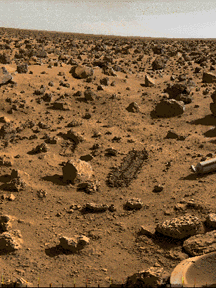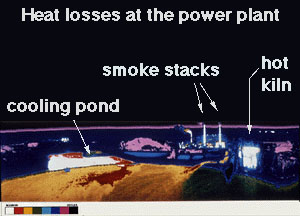Earth


The image at the left shows dry ground in the desert on Earth.
Click on image for full size version (828K JPG).
Images from: NASA/JPL.
The image at the right shows tundra.
Click on image for full size version (128K JPG).
Images from: University of California at Berkeley.
There are many different kinds of soils on the
surface of the
Earth. The desert ground shown here is just one kind of soil. Soils in a
desert have very little water in them. Tundra is a soil type that includes
frozen
water, and is seen at high latitudes on Earth. In addition, many soils on
Earth include a lot of organic matter, due to the presence of
life. | Mars


The image at left shows soils of Mars from the Viking 2 landing
site, Utopia Planitia. Click on image for full size version
(140K GIF). Image from: NASA/JPL.
The right image shows patterned ground at the south pole of Mars. Click on
image for full size version (1M GIF). Image from:
NASA/JPL.
Though the soils of much of Mars seem to be low in water
like a terrestrial desert, studies of the surface have
found water in the soils and atmosphere, in both
solid and vapor form. The patterned ground shown at the right is found
near the south pole of Mars. The patterns in the soil are thought to be
due to the presence of frozen water in the soil. To see the patterns,
click to see the full size (really neat) image.
One of the objectives of the Mars Pathfinder mission was to study the
soil of Mars. Everywhere the Rover passed, it
disturbed the soil. The disturbed soil was a darker
red-brown color than the surrounding soil. The Rover found that much of the
ground is made of dust. The dust may be dropped during
the dust storms that
sweep the planet. The reddish color of the soil is caused
by rust.
Martian soils were studied by Venera, by the Viking lander, and by Mars
Pathfinder. Before the Viking Mission to Mars, knowledge of the kinds of
rocks present on Mars was based on the Martian meteorites. The first
analysis
of Mars soil from Viking landers found no evidence of life, instead showing
that organic molecules are even more scarce than on the Earth's
moon. |
 Leave the Tour and look at the
Annotated map of Mars for the location of Utopia Planitia. (Use the Back button on your browser to get back)
Leave the Tour and look at the
Annotated map of Mars for the location of Utopia Planitia. (Use the Back button on your browser to get back)















